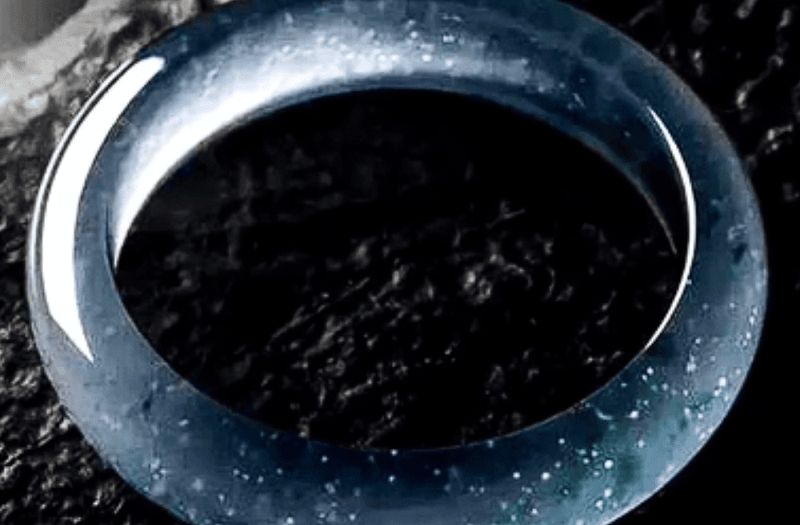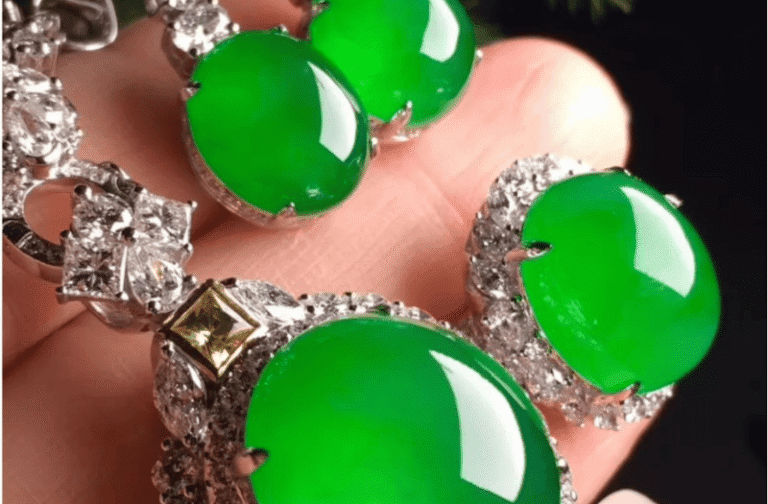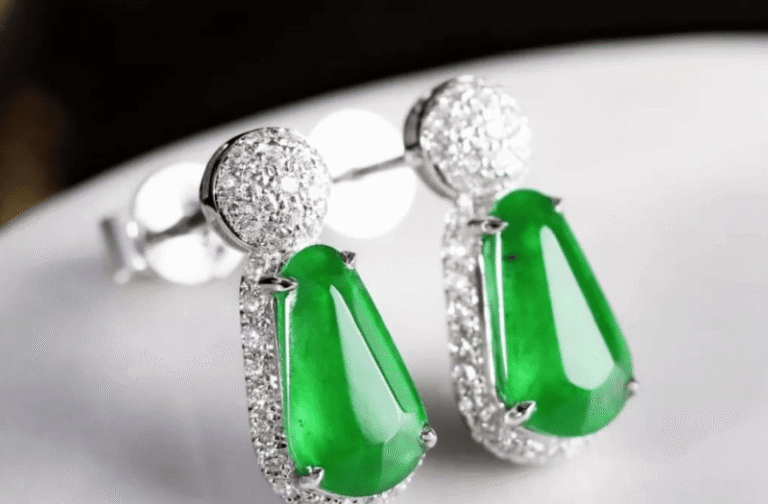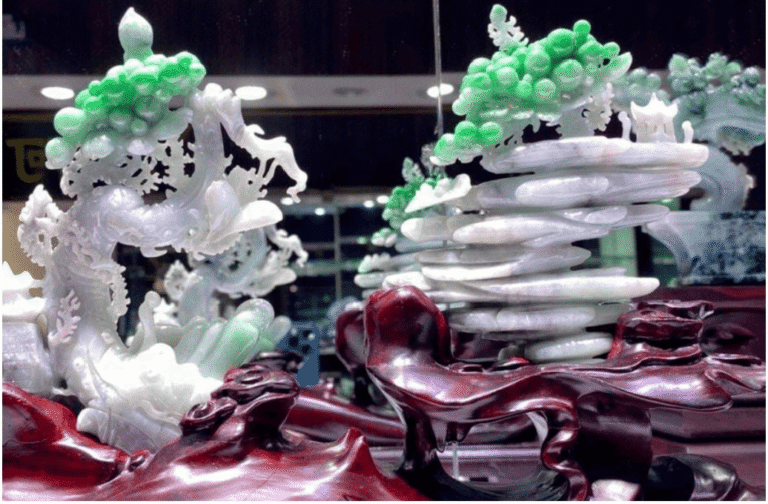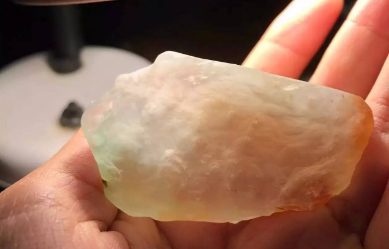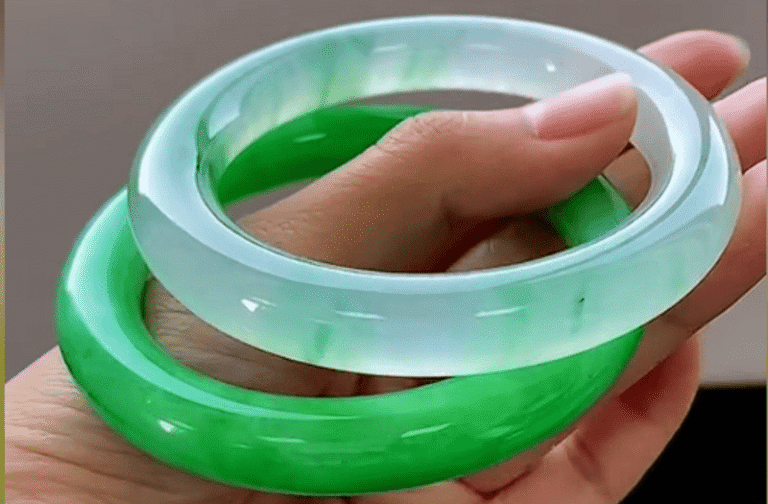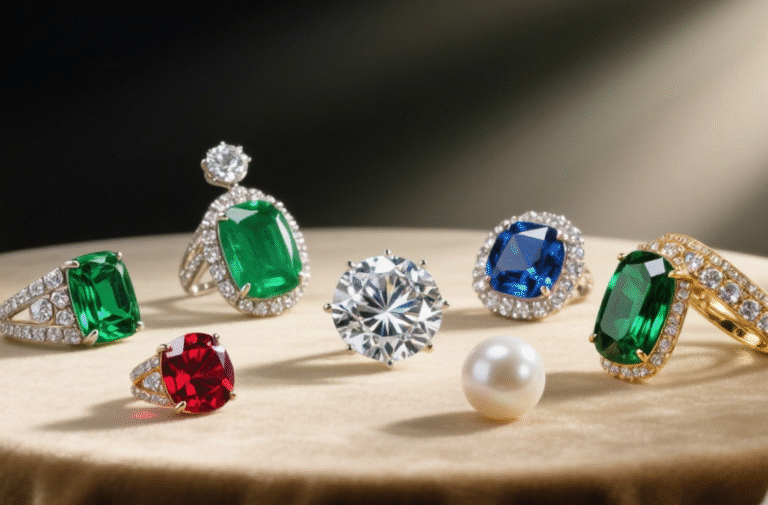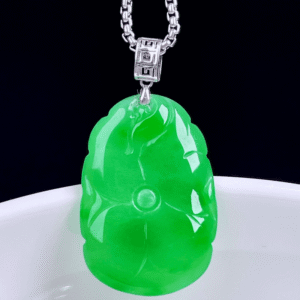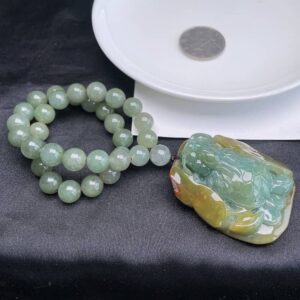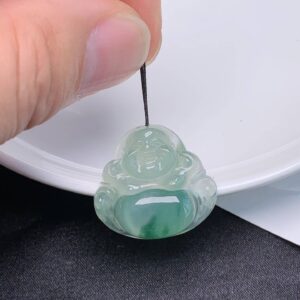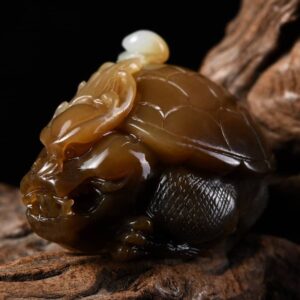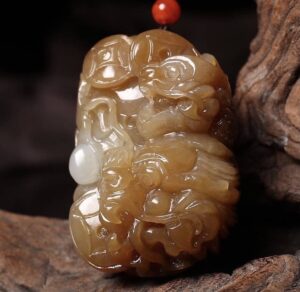Understanding Myanmar jadeite goes beyond a simple appreciation of its beauty; it requires a nuanced grasp of its defining characteristics. While “Gong” (craftsmanship) adds artistry, the inherent value of jadeite truly lies in its “Zhong” (texture/structure), “Shui” (translucency), and “Se” (color). These three elements are intrinsically linked, each influencing and enhancing the others. Let’s delve deeper into these critical classifications to build a more sophisticated eye for this magnificent gemstone.
I. “Zhong” (种): The Foundation of Jadeite – Its Inner Structure and Radiance
“Zhong”, often translated as “kind” or “texture,” refers to the fineness and compactness of the jadeite’s crystalline structure. It’s the most fundamental aspect, dictating how light interacts with the stone, its overall stability, and its potential for brilliance. Think of it as the stone’s inherent quality or its “grain.”
- Why Zhong is Paramount: A superior “Zhong” indicates that the jadeite’s microscopic crystals are tightly interlocked, forming a dense and uniform material. This allows for an exceptional polish, creating a high, glassy luster that makes the jadeite appear vibrant and alive. Conversely, a coarse “Zhong” results in a duller, more porous surface, less resistant to wear and tear.
- Detailed “Zhong” Classifications (from highest to lowest quality):
- Glassy “Zhong” (玻璃种 – Boli Zhong):

- Description: The absolute pinnacle of jadeite quality. Its crystalline structure is so fine and compact that it appears almost perfectly transparent, like a flawless piece of glass. It possesses an unparalleled, brilliant glassy luster.
- Characteristics: Extremely clear, almost no visible grain, exceptional smoothness to the touch, and often exhibits a captivating “gel-like” quality or “glowing” effect (起莹 – Qi Ying) where light seems to emanate from within.
- Value Impact: Commands the highest prices due to extreme rarity and breathtaking beauty.
- Icy “Zhong” (冰种 – Bing Zhong):

- Description: Very fine and dense, appearing semi-transparent to highly translucent, resembling clear ice. You might perceive a very subtle, indistinct grain.
- Characteristics: Good luster, smooth feel, and allows light to penetrate significantly, giving it a cool, refreshing appearance. It’s often used for higher-end jewelry.
- Value Impact: Highly sought after, second only to glassy “Zhong.”
- Glutinous Rice “Zhong” (糯种 – Nuo Zhong):

- Description: The crystal structure is visible but still relatively fine, giving the jadeite a semi-translucent appearance akin to cooked glutinous rice.
- Characteristics: Ranges from translucent (糯化种 – Nuo Hua Zhong, more transparent, like melted glutinous rice) to opaque (糯米种 – Nuo Mi Zhong, more opaque, like uncooked rice grains). Luster is good but less pronounced than icy or glassy.
- Value Impact: Widely popular and available, offering good value for money depending on transparency and color.
- Bean “Zhong” (豆种 – Dou Zhong):

- Description: Features a coarser crystalline structure, where individual crystal grains resemble “beans” to the naked eye. It’s typically opaque or only very slightly translucent.
- Characteristics: Luster is generally duller, and the texture can feel slightly rougher. Colors tend to be less vibrant due to poor light penetration.
- Value Impact: The most common type of jadeite “Zhong,” generally lower in value, often used for mass-produced items.
- Dry Green “Zhong” (干青种 – Gan Qing Zhong):

- Description: Extremely coarse and opaque, with virtually no translucency. The name “dry” aptly describes its appearance.
- Characteristics: Lacks luster, appears dull, and feels rough. While it can have vibrant green color, its poor “Zhong” significantly diminishes its value.
- Value Impact: Lowest in value among genuine jadeite, primarily valued for its color if present, but lacks the essential qualities of fine jadeite.
II. “Shui” (水): Jadeite’s Luminous Heart – The Dance of Light
“Shui”, meaning “water” or “water content,” describes the translucency, clarity, and light-penetrating ability of the jadeite. It’s the “life” or “spirit” of the stone, determining how vibrant and alive it appears.
- Why Shui is Crucial: “Shui” allows light to penetrate deep into the jadeite, diffusing beautifully throughout its structure. This creates a captivating luminosity and depth, making the stone appear more vibrant and giving it a unique ethereal quality. A stone with good “Shui” can make even a paler color appear more alluring.
- Detailed “Shui” Classifications (from highest to lowest transparency):
- High “Shui” / Glassy (玻璃水 – Boli Shui):
- Description: The highest level of translucency, where the jadeite appears perfectly clear and transparent, like pure glass.
- Characteristics: Light passes through almost unobstructed, creating exceptional brilliance and depth. Often found in “Glassy Zhong” jadeite.
- Value Impact: Extremely rare and highly valued, contributing significantly to the overall price.
- Good “Shui” / Icy (冰水 – Bing Shui):
- Description: Excellent translucency, resembling clear ice cubes. Light penetrates very well, giving a bright and refreshing feel.
- Characteristics: Items behind the jadeite can be vaguely seen, but without sharp focus. Found in “Icy Zhong” jadeite.
- Value Impact: Very desirable and commands high prices.
- Medium “Shui” / Glutinous Rice (糯化水 – Nuo Hua Shui):
- Description: Semi-translucent with a slightly hazy or milky appearance, similar to melted glutinous rice. Light penetration is moderate.
- Characteristics: Objects behind the jadeite appear blurry and indistinct.
- Value Impact: Common in good to medium-quality jadeite, offering a balance of beauty and affordability.
- Low “Shui” / Bean (豆水 – Dou Shui):
- Description: Low translucency, appearing mostly opaque with very little light penetration.
- Characteristics: Very difficult or impossible to see objects through the jadeite. Found in “Bean Zhong” jadeite.
- Value Impact: Generally lower value, as the lack of light penetration diminishes its visual appeal.
- No “Shui” / Dry (干水 – Gan Shui):
- Description: Completely opaque, with no light passing through.
- Characteristics: Appears dull and lifeless. Found in “Dry Green Zhong” or other opaque varieties.
- Value Impact: Least valuable due to the absence of translucency.
- High “Shui” / Glassy (玻璃水 – Boli Shui):
III. “Se” (色): Jadeite’s Captivating Hues – The Symphony of Color
“Se”, or “color,” is perhaps the most immediately striking and emotionally appealing aspect of jadeite. While various colors exist, a vivid, rich green is overwhelmingly the most coveted. The value of jadeite color is judged by five key criteria: Purity (正 – Zheng), Intensity (阳 – Yang), Evenness (匀 – Yun), Vibrancy (俏 – Qiao), and Richness (浓 – Nong).
- Why Color is Key (but not everything): Color is the soul of jadeite’s beauty, but its impact is maximized when combined with excellent “Zhong” and “Shui.” A vibrant color in a high-translucency stone appears far more striking than the same color in an opaque piece.
- Detailed “Se” Classifications (Focusing on Green, the Most Prized):
- Imperial Green (帝王绿 – Di Wang Lü):
- Description: The absolute pinnacle of jadeite color. A pure, intense, emerald-like green, with exceptional saturation and often a very slight bluish tint that makes it incredibly vibrant.
- Characteristics: The color is uniform and penetrates deeply, appearing vivid and striking under various lighting conditions. It feels regal and profound.
- Value Impact: Extremely rare and commands astronomical prices, often setting world records at auctions.
- Apple Green (苹果绿 – Ping Guo Lü):
- Description: A bright, lively green, often slightly lighter than Imperial Green, resembling the vibrant green of a Granny Smith apple.
- Characteristics: Color is pure, saturated, and very appealing, radiating freshness and vitality.
- Value Impact: Highly desirable and valuable, particularly when combined with good “Zhong” and “Shui.”
- Spinach Green (菠菜绿 – Bo Cai Lü):
- Description: A darker, often slightly bluish-green, reminiscent of spinach. The color is deep and rich.
- Characteristics: Can appear quite intense, but might lack the immediate brilliance of apple green if translucency isn’t optimal.
- Value Impact: Still valuable, especially if the color is even and “live.” Often used in more traditional designs.
- Moss-in-Snow (雪中送炭 – Xue Zhong Song Tan / 墨绿 – Mo Lü):
- Description: Refers to white or pale translucent jadeite with distinct, irregular spots or streaks of dark green color, resembling moss on snow.
- Characteristics: The contrast between the light background and the dark green spots creates a unique visual effect.
- Value Impact: Highly dependent on the distribution and beauty of the “moss” pattern. A well-placed pattern can significantly increase value.
- Pale Green / Light Green (淡绿 – Dan Lü):
- Description: A light, often faint green hue.
- Characteristics: Color may appear diluted, but can still be charming, especially if the “Zhong” and “Shui” are exceptional, giving it a delicate glow.
- Value Impact: Generally lower in value compared to richer greens, but quality “Zhong” and “Shui” can elevate its appeal.
- Imperial Green (帝王绿 – Di Wang Lü):
- Other Notable Colors:
- Lavender / Violet (紫罗兰 – Zi Luo Lan): Ranges from pale lilac to deep purple. Highly sought after, especially the richer, pure violet hues.
- Yellow / Red (黄翡 – Huang Fei / 红翡 – Hong Fei): Often occur as external skin colors, formed by iron oxidation. Rich, vibrant reddish-orange or golden-yellow hues are valuable, particularly if transparent.
- Black (墨翠 – Mo Cui): Appears black due to dense chromite inclusions, but holds a deep green translucency when held against strong light. Symbolizes protection.
Conclusion: The Holistic Beauty of Jadeite
Understanding the detailed classifications of “Zhong,” “Shui,” and “Se” provides a robust framework for appreciating Myanmar jadeite. Each element contributes uniquely to the stone’s beauty and value, yet they work in harmony. A piece with exceptional “Zhong” will enhance its “Shui” and bring out the vibrancy of its “Se.” A rare, vivid “Se” is truly magnificent only when it possesses good “Zhong” and “Shui” to let its color breathe.
As you continue your journey into the world of jadeite, remember these distinctions are not just academic. They are the language of connoisseurs, revealing the intricate dance of nature and time that creates these extraordinary gemstones. The more you train your eye to discern these subtle differences, the deeper your appreciation for the “Soul of Myanmar Jadeite” will become.

